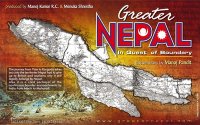Film Review: Greater Nepal
Posted by completenepal on February 9, 2010
I recently saw a documentary organised by London Chhalphal called Greater Nepal. The film suggests Greater Nepal  needs to be reclaimed. It was ‘lost’ in the 1816 Treaty of Segauli by which British India gained areas of border land which Manoj Pandit’s documentary suggest should be returned to Nepal. For those who know Greater Nepal was defined as stretching from the Teesta river in the east to Kangra Fort in the west.
needs to be reclaimed. It was ‘lost’ in the 1816 Treaty of Segauli by which British India gained areas of border land which Manoj Pandit’s documentary suggest should be returned to Nepal. For those who know Greater Nepal was defined as stretching from the Teesta river in the east to Kangra Fort in the west.
The film is let down by a weak first historical half. Pandit’s view of Nepali history focuses on wars, military battles and the ‘great men’ of the past. History for Pandit is a collection of unchanging facts to be used in the service of a nation. The usual roll call of ‘heroes and builders of Nepal’ appears with the assumption that they are heroes for every Nepali today (not true). In typical nationalist fashion the military expansion of the early Gorkhali state is portrayed as unequivocally heroic. Those who were conquered by the Nepalis might have something to say about that. The late Nepali historian, Mahesh Chandra Regmi, certainly did and spent a large part of his career writing about the imperial, extractive and oppressive nature of the Gorkhali empire. Many Nepalis today might also contest Pandit’s rastriya itihaas (national history), let alone those now living in lands claimed by the Greater Nepal movement.
The film is full of other sympathetic academics and quite disturbing Greater Nepal activists who each invoke human rights, factual ‘proof’ and spurious legal arguments to attack the 1816 Segauli Treaty and claim the land back. One particularly bad scene invokes the Gorkhaland movement in 1980s Darjeeling. Contrary to Pandit’s claim this movement certainly didn’t wish to become part of a Greater Nepal. Fortunately the film’s second half is better since Pandit travels around Nepal and interviews people who clearly care about seeing their fields and homes snatched by India. Clearly many people on the border do feel threatened in various ways. Amidst all this there is one funny tale of Nepali surveyors who abandoned their jobs at one section on the border to ‘go to Darjeeling for amusement’! This laziness left the sneaky Indian surveyors to claim more land in India’s favour.
On the surface the film only highlights the director’s ignorance of Nepali history. The work of Regmi is ignored but so is the more recent work of many other Nepali historians. But this documentary, however, like the Greater Nepal movement in general, isn’t really interested in academic arguments. The film also never once mentions the Maoists and only (cheaply) fits in the recent People’s Movement at the end. It actually is a call to return to a different kind of debate. When all is unstable and change is in the air then, for Pandit and others, it is easier to put the blinkers on and return to good old-fashioned nationalist and anti-Indian thoughts. The film does raise interesting questions when it looks at Nepali realties on the border today. But Pandit’s historical arguments and the Greater Nepal movement’s central aims represent something of a last desperate revival of the old certainties, and a late attempt to change the debate. Fortunately history and politics in Nepal seem to have moved on.
Source: mesocosm




















Leave a comment